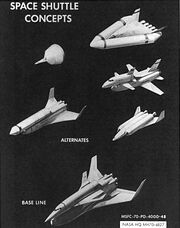| Line 21: | Line 21: | ||
===Accidents=== |
===Accidents=== |
||
| + | [[File:Challenger_explosion-1-.jpg|thumb|n 1986, Challenger disintegrated 1 minute 13 seconds after liftoff]] |
||
==Status Quo== |
==Status Quo== |
||
Revision as of 03:10, 30 November 2012
Space Transportation System (STS) is the NASA's Space Shuttle program and was the United States

Space Shuttle Program Logo
government's manned launch vehicle program from 1981 to 2011. The winged Space Shuttle orbiter was launched vertically, usually carrying four to seven astronauts (although eight have been carried) and up to 50,000 lb (22,700 kg) of payload into low Earth orbit (LEO). When its mission was complete, the Shuttle could independently move itself out of orbit using its Manoeuvring System (it oriented itself appropriately and fired its main OMS engines, thus slowing it down) and re-enter the Earth's atmosphere. During descent and landing the orbiter acted as a re-entry vehicle and a glider, using its OMS system and flight surfaces to make adjustments.
The Shuttle is the only winged manned spacecraft to have achieved orbit and land, and the only reusable space vehicle that has ever made multiple flights into orbit (though winged, the Russian shuttle Buran made only one unmanned spaceflight). Its missions involved carrying large payloads to various orbits (including segments to be added to the International Space Station), provided crew rotation for the International Space Station, and performing service missions. The orbiter also recovered satellites and other payloads (e.g. from the ISS) from orbit and returned them to Earth, though its use in this capacity was rare. Each vehicle was designed with a projected lifespan of 100 launches, or 10 years' operational life.
The program formally commenced in 1972, although the concept had been explored since the late 1960s, and was the sole focus of NASA's manned operations after the final Apollo and Skylab flights in the mid-1970s. The Shuttle was originally conceived of and presented to the public in 1972 as a 'Space Truck' which would, among other things, be used to build a United States space station in low earth orbit in the early-1990s and then be replaced by a new vehicle.
When the concept of the U.S. space station evolved into that of the International Space Station, which suffered from long delays and design changes before it could be completed, the service life of the Space Shuttle was extended several times until 2011 when it was finally retired — serving at least 15 years longer than it was originally designed to do. In 2004, according to the President George W. Bush's Vision for Space Exploration, use of the Space Shuttle was to be focused almost exclusively on completing assembly of the ISS, which was far behind schedule at that point.
The first experimental orbiter was delivered for atmospheric handling test flights in 1976, and the first launch took place on April 12, 1981, with Columbia and STS-1, the first Shuttle orbital flight. The Space Shuttle program finished with its last mission, STS-135 flown by Atlantis, in July 2011, retiring the final Shuttle in the fleet. The Space Shuttle program formally ended on August 31, 2011.
Retirement of the Shuttle - the most complex vehicle ever built - ended the era in which all of America's varied space activities were performed by one craft -or even one organization. Functions performed by the Shuttle for 30 years will be done by not one but many different spacecraft currently flying or in advanced development. Secret military missions are being flown by the US Air Force's "highly successful" unmanned mini-space plane, the X-37B.
By the end of 2012 cargo supply to the International Space Station will be flown by privately owned commercial craft under NASA's Commercial Resupply Services by SpaceX's successfully tested the partially reusable Dragon Spacecraft, and Orbital Sciences' Cygnus Spacecraft (also slated for testing in 2012).
Crew service to ISS will be flown exclusively by the Russian's Soyuz while NASA works on the Commercial Crew Development program. For missions beyond low Earth orbit NASA is building the Space Launch System and the Orion Spacecraft.

Early U.S. space shuttle concepts
Conception and Development
Program History
Accidents

n 1986, Challenger disintegrated 1 minute 13 seconds after liftoff